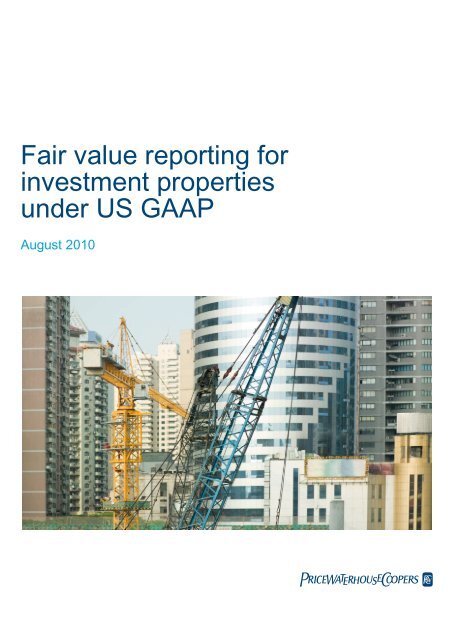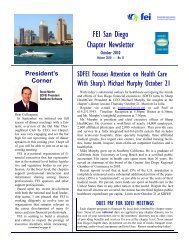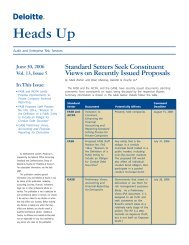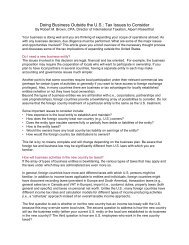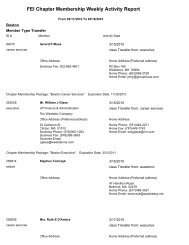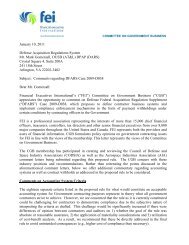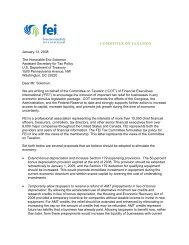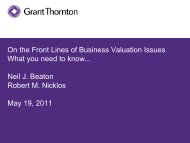Fair value reporting for investment properties under US GAAP
Fair value reporting for investment properties under US GAAP
Fair value reporting for investment properties under US GAAP
Create successful ePaper yourself
Turn your PDF publications into a flip-book with our unique Google optimized e-Paper software.
<strong>Fair</strong> <strong>value</strong> <strong>reporting</strong> <strong>for</strong><br />
<strong>investment</strong> <strong>properties</strong><br />
<strong>under</strong> <strong>US</strong> <strong>GAAP</strong><br />
August 2010<br />
1
Table of contents<br />
Executive summary .......................................................................................................................................................1<br />
History of the <strong>US</strong> <strong>investment</strong> property standard proposal...............................................................................................1<br />
History of <strong>investment</strong> property standard <strong>under</strong> IFRS......................................................................................................3<br />
Definition of <strong>investment</strong> property <strong>under</strong> IAS 40 ..............................................................................................................4<br />
Examples of <strong>investment</strong> property <strong>under</strong> IAS 40..............................................................................................................6<br />
Difficulties in applying IAS 40 and <strong>Fair</strong> Value Accounting <strong>for</strong> Investment Property .........................................................6<br />
Potential issues in applying an <strong>investment</strong> property standard in the United States.........................................................7<br />
Timetable <strong>for</strong> the proposed standard ...........................................................................................................................10<br />
Contact us ...................................................................................................................................................................11
Executive summary<br />
At its July 14, 2010 meeting, the Financial Accounting Standards Board ("FASB") tentatively decided to issue a<br />
proposed Accounting Standard Update (“ASU”) to attempt to achieve convergence with International Accounting<br />
Standards (“IAS”) on accounting <strong>for</strong> <strong>investment</strong> <strong>properties</strong>. However, the FASB concluded that, as opposed to the<br />
international accounting standard on <strong>investment</strong> property, which provides an option to account <strong>for</strong> <strong>investment</strong> property<br />
at cost or fair <strong>value</strong>, the <strong>US</strong> standard, would require an <strong>investment</strong> property to be measured at fair <strong>value</strong>. This new<br />
guidance is partially driven by the recently issued Exposure Draft <strong>for</strong> leasing. Assuming that both standards are<br />
adopted, lessors who are in the scope of the <strong>investment</strong> property guidance would not apply the new leasing standard.<br />
An <strong>investment</strong> property is defined as real estate (including integral equipment) held by the owner or held on a finance<br />
lease (<strong>under</strong> certain circumstances operating leases may also be classified as <strong>investment</strong> <strong>properties</strong>) to earn rentals,<br />
<strong>for</strong> capital appreciation, or both. This does not include owner-occupied property, property held <strong>for</strong> sale in the ordinary<br />
course of business (e.g., residential homes held by a home builder), or property constructed on behalf of third parties.<br />
The exposure draft could be issued as early as September 2010, with an abbreviated comment letter period expected<br />
to end December 15, 2010 (concurrently with that of the exposure draft on the Lease Project issued in August). If<br />
completed, it is expected that the new <strong>investment</strong> property standard will be adopted concurrently with the proposed<br />
new leasing standard. The date of adoption of the new leasing standard has not yet been determined, but could be as<br />
early as 2013/2014.<br />
Who could be affected?<br />
This new guidance will have broad implications to many owners/investors in real estate and could impact the following entities:<br />
• Real Estate Investment Trusts (REITs)<br />
• Real Estate Operating Companies (REOCs)<br />
• Insurance companies (e.g., general account <strong>investment</strong>s)<br />
• Banks (e.g., real estate <strong>investment</strong>s and some OREO assets)<br />
• Owner entities <strong>for</strong> “non-traditional” real estate that may be “leased” <strong>under</strong> take or pay/power purchase arrangements – including power<br />
plants, oil/gas pipelines, wind/solar farms, and production facilities<br />
• “Property Companies” in “OPCo./PropCo” structures used by private equity firms <strong>for</strong> certain portfolio <strong>investment</strong>s<br />
• Owners of <strong>properties</strong> leased to other affiliated companies<br />
• Franchisors that lease property to franchisees<br />
• All other investors in rental real estate<br />
History of the <strong>US</strong> <strong>investment</strong> property standard proposal<br />
As part of the overall convergence ef<strong>for</strong>ts, the FASB and the International Accounting Standards Board (“IASB”)<br />
recently completed an exposure draft <strong>for</strong> their joint project on accounting <strong>for</strong> leases, which will result in significant<br />
changes to the accounting model <strong>for</strong> leases. The IASB included a scope exception within the exposure draft that if a<br />
lessor of “<strong>investment</strong> <strong>properties</strong>” measures those <strong>properties</strong> at fair <strong>value</strong> in accordance with International Accounting<br />
Standards (“IAS”) 40, Investment Property (“IAS 40”), it would not apply the proposed new lessor accounting<br />
requirements to the lease. Instead, it would continue to account <strong>for</strong> those leases as operating leases, as specified in<br />
IAS 17, Leases. This decision assumes that fair <strong>value</strong> is a more in<strong>for</strong>mative and preferred model. Currently, there is no<br />
<strong>Fair</strong> <strong>value</strong> <strong>reporting</strong> <strong>for</strong> <strong>investment</strong> <strong>properties</strong> 1 PricewaterhouseCoopers
equivalent <strong>US</strong> standard that allows <strong>for</strong> <strong>investment</strong> <strong>properties</strong> to be measured at fair <strong>value</strong> and there would be no basis<br />
<strong>for</strong> excluding <strong>investment</strong> <strong>properties</strong> from the new proposed lessor accounting requirements.<br />
To remedy this lack of consistency between IASB and FASB guidance, and at the request of some participants in the<br />
real estate industry, the FASB announced at its March 10, 2010 meeting that it was adding a project to its agenda to<br />
consider whether entities should be given the option (or potentially be required) to measure an <strong>investment</strong> property at<br />
fair <strong>value</strong> through profit and loss (FVTPL). A similar project previously had been on the FASB’s agenda <strong>under</strong> phase<br />
two of the fair <strong>value</strong> option project, but was removed from the agenda in October 2008, partially because of resistance<br />
to optional fair <strong>value</strong> accounting by the SEC Advisory Committee on Improvements to Financial Reporting and<br />
concerns about the use of fair <strong>value</strong> models in general <strong>for</strong> "non-traded" assets. Staff resource constraints are also<br />
believed to have played a role in the original removal of the project from the agenda, with the expectation that the<br />
United States would ultimately adopt IFRS, including IAS 40.<br />
At its July 14, 2010 meeting, the FASB discussed the <strong>investment</strong> property project and certain proposed models put<br />
<strong>for</strong>th by the staff. Rather than starting with a new model, the FASB tentatively decided to issue a proposed Accounting<br />
Standard Update using IAS 40 as a basis, however the ASU would require an <strong>investment</strong> property to be measured at<br />
fair <strong>value</strong>. The FASB recognized that its tentative decision would not achieve complete convergence with IAS 40, which<br />
permits, but does not require, <strong>investment</strong> <strong>properties</strong> to be measured at fair <strong>value</strong>. Nonetheless, the FASB instructed the<br />
staff to begin drafting the ASU and to continue to reach out to constituents and hear their concerns and thoughts. It is<br />
also possible that the IASB will amend IAS 40 to be consistent with this new ASU and require the use of fair <strong>value</strong> <strong>for</strong><br />
<strong>investment</strong> <strong>properties</strong>. The exposure draft <strong>for</strong> Accounting <strong>for</strong> Investment Properties could be issued as early as<br />
September 2010, with a comment period to end contemporaneously with that of the lease standard (i.e., December 15,<br />
2010).<br />
In the United States there are certain entities that currently report <strong>investment</strong> property at fair <strong>value</strong>, including pension<br />
funds and entities that are considered to be <strong>investment</strong> companies <strong>under</strong> ASC 946 (<strong>for</strong>merly the AICPA Audit and<br />
Accounting Guide - Investment Companies). As part of the convergence project on consolidation, the IASB is nearing<br />
the issuance of an exposure draft on the definition of an <strong>investment</strong> company, a designation that did not previously<br />
exist in IFRS. The discussion to date bears striking similarities to SOP 07-1, Clarification of the Scope of the Audit and<br />
Accounting Guide "Investment Companies" and Accounting by Parent Companies and Equity Method Investors <strong>for</strong><br />
Investments in Investment Companies, issued by the AICPA in 2007 and subsequently indefinitely deferred. If the<br />
FASB adopts a similar definition or ultimately converts to IFRS, entities will need to re-evaluate whether they are or are<br />
not <strong>investment</strong> companies <strong>under</strong> the new guidance; and if not, if they would no longer be able to report as <strong>investment</strong><br />
companies. In some cases, certain real estate entities (generally vertically integrated property operating companies)<br />
may no longer qualify as <strong>investment</strong> companies, but many investors in those entities may still need fair <strong>value</strong><br />
in<strong>for</strong>mation <strong>for</strong> their own <strong>reporting</strong> (e.g. pension funds). If adopted by the FASB, this new guidance on <strong>investment</strong><br />
<strong>properties</strong> may provide some relief <strong>for</strong> those funds that would no longer be within the scope of an <strong>investment</strong> company,<br />
by requiring <strong>investment</strong> <strong>properties</strong> to be reflected at fair <strong>value</strong> <strong>under</strong> non-<strong>investment</strong> company <strong>US</strong> <strong>GAAP</strong>. On the other<br />
hand, because of the definition of “<strong>investment</strong> property” within IAS 40, some <strong>investment</strong>s, such as hotels and assistedliving<br />
facilities, which had historically been reported by these <strong>investment</strong> company entities at fair <strong>value</strong>, may no longer<br />
have a basis to be reported at fair <strong>value</strong> because the entities owning such property may not be <strong>investment</strong> companies<br />
and the property may not meet the definition of an <strong>investment</strong> property.<br />
For entities that historically have not been deemed to be <strong>investment</strong> companies, but which have owned or operated<br />
rental <strong>properties</strong>, the current <strong>reporting</strong> model is based on the historical cost of the property as adjusted <strong>for</strong> depreciation<br />
and impairment. Depending on the type of <strong>under</strong>lying <strong>properties</strong>, this includes many of the real estate <strong>investment</strong> trusts<br />
(REITs) and real estate operating companies (REOCs). In addition, many financial institutions, such as banks and<br />
insurance companies, which hold such <strong>investment</strong>s <strong>for</strong> their own account (i.e., “general account” <strong>investment</strong>s), will also<br />
be affected if these <strong>investment</strong>s meet the definition of <strong>investment</strong> property. Absent the ability to reconsider fair <strong>value</strong><br />
elections on related debt financing these <strong>investment</strong>s (both recourse and non-recourse), many of these financial<br />
<strong>Fair</strong> <strong>value</strong> <strong>reporting</strong> <strong>for</strong> <strong>investment</strong> <strong>properties</strong> 2 PricewaterhouseCoopers
institutions could have mismatches, creating unusual net results with liabilities carried at amortized cost. IAS 39.9<br />
allows the classification of such liabilities at FVTPL in order to eliminate a mismatch (where applicable).<br />
This new FASB guidance could also affect owners of “non-traditional” real estate, such as production facilities, power<br />
plants, wind/solar farms, or pipelines, which otherwise may meet the definition of an <strong>investment</strong> property, and which<br />
are subject to “leases,” either directly or through take-or-pay contracts or power purchase contracts <strong>under</strong> ASU 840-10-<br />
15 (<strong>for</strong>merly EITF 01-8). While international standards (International Financial Reporting Interpretations Committee<br />
["IFRIC"] 4) have equivalent lease definitions, whether or not they were considered <strong>investment</strong> property <strong>under</strong> IAS 40<br />
has not been a focus <strong>for</strong> owners of these assets because fair <strong>value</strong> <strong>reporting</strong> has been optional. In addition, due to the<br />
complexities of valuation, historical cost has generally been elected. Since the FASB’s new <strong>investment</strong> property<br />
standard would not allow <strong>for</strong> such an option, the evaluation of whether these are considered “<strong>investment</strong> <strong>properties</strong>” will<br />
be critical.<br />
Banks and other financial institutions also receive property in <strong>for</strong>eclosure (i.e., other real estate owned or “OREO”<br />
assets) that they may hold <strong>for</strong> sale/rent <strong>for</strong> a period of time to maximize their returns/recovery. These OREO assets<br />
may meet the definition of an <strong>investment</strong> property and may be required to change from the current historical cost model<br />
to a fair <strong>value</strong> model once obtained in <strong>for</strong>eclosure until their ultimate disposal.<br />
Many historical cost-<strong>reporting</strong> entities, such as REITs/REOCs, have long disagreed with the concept of depreciating<br />
“appreciating assets,” which has lead them to provide the market with alternative measures of per<strong>for</strong>mance, such as<br />
Funds from Operations (“FFO”). FFO excludes the impact of depreciation of these real estate assets from earnings.<br />
Others have argued that the asset on the balance sheets of REIT and REOCs were not comparable among companies<br />
because property acquisitions are recorded at historical cost at the time of acquisition (which is at different times <strong>for</strong><br />
different acquisitions and different companies) and subsequently were depreciated using a method that doesn’t<br />
necessarily reflect the real economic decline in <strong>value</strong> of a property. These industry participants believe that fair <strong>value</strong><br />
<strong>reporting</strong> would improve the relevance of financial <strong>reporting</strong>. Critics of the fair <strong>value</strong> model note that real estate<br />
valuations are generally level 3 <strong>under</strong> the current fair <strong>value</strong> framework and point to the inherent uncertainty of<br />
valuations and potential differences of assumptions such as market rents or discount and cap rates by different parties<br />
<strong>for</strong> similar <strong>properties</strong>. These critics believe that fair <strong>value</strong> <strong>reporting</strong> would not improve the comparability of financial<br />
statements among different real estate companies. Ultimately, it remains to be seen whether the public markets will<br />
embrace this change or not.<br />
History of <strong>investment</strong> property standard <strong>under</strong> IFRS<br />
Prior to the adoption of IFRS, the accounting <strong>for</strong> <strong>investment</strong><br />
<strong>properties</strong> was governed by local <strong>GAAP</strong>. Although the accounting<br />
in each jurisdiction varied, it generally followed either the<br />
historical cost model or the revaluation model, or an option to<br />
choose between the two. The cost model was based on the<br />
historical cost of the property as adjusted <strong>for</strong> depreciation and<br />
impairment. Under the revaluation model, <strong>properties</strong> were carried<br />
at fair <strong>value</strong>, with changes in fair <strong>value</strong> recorded in equity. The fair<br />
<strong>value</strong> model, in which <strong>properties</strong> are carried at fair <strong>value</strong> with<br />
changes in fair <strong>value</strong> through profit or loss, was generally not<br />
applied internationally prior to the adoption of IAS 40. Under IFRS<br />
(specifically IAS 40), the initial measurement of an <strong>investment</strong><br />
property is its purchase price plus any directly attributable<br />
transaction costs. Subsequent to initial measurement,<br />
<strong>Fair</strong> <strong>value</strong> <strong>reporting</strong> <strong>for</strong> <strong>investment</strong> <strong>properties</strong> 3 PricewaterhouseCoopers<br />
Global Survey of listed Investment<br />
Property owners*<br />
8%<br />
92%<br />
Applied the fair<br />
<strong>value</strong> model <strong>for</strong><br />
subsequent<br />
measurement<br />
of <strong>investment</strong><br />
property<br />
Applied the<br />
cost model<br />
* In a 2008 global survey of listed <strong>investment</strong> property owners<br />
conducted by PricewaterhouseCoopers - 50 entities surveyed.
management makes a policy election to either carry an <strong>investment</strong> property at fair <strong>value</strong>, or at cost (less depreciation<br />
and impairment).<br />
In practice, the vast majority of companies in most jurisdictions that apply IFRS have elected to carry their <strong>investment</strong><br />
<strong>properties</strong> at fair <strong>value</strong>. In certain jurisdictions, there has been less use of fair <strong>value</strong> because of a lack of valuation<br />
infrastructure or <strong>for</strong> competitive reasons. However <strong>under</strong> IFRS, when a company elects the cost model, they must still<br />
disclose fair <strong>value</strong> in<strong>for</strong>mation. In addition, the adoption of IAS 40 took place during a period when real estate <strong>value</strong>s<br />
were generally increasing, and this undoubtedly created a bias toward the use of the fair <strong>value</strong> model. It is not clear,<br />
however, how the percentage <strong>for</strong> those electing fair <strong>value</strong> would have changed if the adoption of IAS 40 had occurred<br />
in a poor economic environment with declining real estate <strong>value</strong>s. The policy chosen is applied consistently to all of the<br />
<strong>investment</strong> <strong>properties</strong> that the entity owns (i.e., it cannot be applied selectively), and a change from one model to the<br />
other can be made only if it will result in a more appropriate presentation. As noted specifically in IAS 40, however, a<br />
change from fair <strong>value</strong> to cost is not likely to be considered a more appropriate presentation and is generally not<br />
acceptable. Once elected, there is effectively no going back.<br />
Definition of <strong>investment</strong> property <strong>under</strong> IAS 40<br />
Investment property is defined <strong>under</strong> IAS 40 as:<br />
• Property held by the owner; held on a finance lease to earn rentals or <strong>for</strong> capital appreciation; or both<br />
• Existing <strong>investment</strong> property that is being redeveloped <strong>for</strong> continued use as an <strong>investment</strong> property in the future<br />
Effective in 2008, <strong>investment</strong> <strong>properties</strong> in the course of construction or development are also within the scope of IAS<br />
40 (previously they were accounted <strong>for</strong> as Property, Plant, and Equipment ("PPE") at historical cost until the completion<br />
of the construction). Where fair <strong>value</strong> is elected <strong>under</strong> IAS 40, such a property is generally measured at fair <strong>value</strong>;<br />
however, if the <strong>value</strong> of the <strong>investment</strong> property <strong>under</strong> construction is not reliably measurable, it is measured at cost<br />
until the earlier of the date construction is completed or the date at which fair <strong>value</strong> becomes reliably measurable.<br />
The following are examples of <strong>investment</strong> property <strong>under</strong> IAS 40:<br />
• Land held <strong>for</strong> long-term capital appreciation rather than <strong>for</strong> short-term sale in the ordinary course of business<br />
• Land held <strong>for</strong> a currently undetermined future use If an entity has not determined that it will use the land as owneroccupied<br />
property or <strong>for</strong> short-term sale in the ordinary course of business, the land is regarded as held <strong>for</strong> capital<br />
appreciation.<br />
• A building owned by the entity (or held by the entity <strong>under</strong> a finance lease) and leased out <strong>under</strong> one or more<br />
operating leases<br />
• A building that is vacant but is expected to be leased out <strong>under</strong> one or more operating leases<br />
• Property that is being constructed or developed <strong>for</strong> future use as <strong>investment</strong> property<br />
The definition specifically excludes the following:<br />
• Owner-occupied property<br />
• Property intended <strong>for</strong> sale in the ordinary course of business<br />
• Property being constructed on behalf of third parties<br />
<strong>Fair</strong> <strong>value</strong> <strong>reporting</strong> <strong>for</strong> <strong>investment</strong> <strong>properties</strong> 4 PricewaterhouseCoopers
Leasehold interests<br />
A property interest that is held by a lessee (i.e., a lease “In” or a “Head Lease”) <strong>under</strong> an operating lease may be<br />
classified and accounted <strong>for</strong> as <strong>investment</strong> property, provided that it meets the following criteria:<br />
• All other definition criteria of <strong>investment</strong> property are met<br />
• The operating lease is accounted <strong>for</strong> as if it were a finance lease<br />
• The lessee uses the fair <strong>value</strong> model<br />
This allows leasehold interests <strong>under</strong> operating leases which would otherwise have no carrying <strong>value</strong> to be accounted<br />
<strong>for</strong> as <strong>investment</strong> property. For example, a leasehold interest in land would normally be an operating lease <strong>under</strong><br />
current international leasing standards; without this special treatment, there would have been no asset to reflect at fair<br />
<strong>value</strong>. If the new lease model is finalized as currently proposed, there will no longer be a need <strong>for</strong> this specialization<br />
since there would be a right-to-use asset recorded.<br />
Multipurpose property<br />
Separate accounting should be applied where a property is used <strong>for</strong> both <strong>investment</strong> purposes and administrative<br />
or/productive purposes. One portion should be accounted <strong>for</strong> as an <strong>investment</strong> property and the other as PPE.<br />
Separate accounting can be applied only if it is possible <strong>for</strong> the portions to be sold separately (or leased separately<br />
<strong>under</strong> a finance lease). The existence of a third-party lessee indicates that a separate sale or finance lease is possible.<br />
If they cannot be sold separately, the entire property is treated as <strong>investment</strong> property only if an insignificant portion is<br />
held <strong>for</strong> use in the production or supply of goods or services or <strong>for</strong> administrative purposes.<br />
Services provided to occupants of property<br />
In cases where an entity provides ancillary services to occupants of a property owned by the entity, the property is<br />
considered an <strong>investment</strong> property if such services are a relatively insignificant portion of the arrangement as a whole.<br />
If such services are more significant, such as in a hotel, the property is treated not as <strong>investment</strong> property, but as an<br />
owner-occupied property. Significant judgment is required to determine whether a property qualifies as <strong>investment</strong><br />
property when ancillary services are provided.<br />
Property occupied by group members, associated companies, or joint ventures<br />
In cases where property is leased from one member of a group to another, and occupied by that other, the property is<br />
not an <strong>investment</strong> property from the standpoint of the consolidated group as a whole -- that is, it is not treated as<br />
<strong>investment</strong> property in the consolidated financial statements. However, it may qualify as <strong>investment</strong> property in the<br />
individual financial statements of the group company that is the lessor, if it meets the other conditions set out in the<br />
definition.<br />
Property occupied by an associated company or joint venture accounted <strong>for</strong> using the equity method should be<br />
accounted <strong>for</strong> as <strong>investment</strong> property in the consolidated financial statements. Associates and joint ventures accounted<br />
<strong>for</strong> using the equity method are not part of the consolidated group, and there<strong>for</strong>e the property is not owner occupied<br />
from the group’s perspective.<br />
<strong>Fair</strong> <strong>value</strong> <strong>reporting</strong> <strong>for</strong> <strong>investment</strong> <strong>properties</strong> 5 PricewaterhouseCoopers
Examples of <strong>investment</strong> property <strong>under</strong> IAS 40<br />
The model does not easily lend itself to broad categorization of <strong>investment</strong> <strong>properties</strong> by property type without<br />
consideration of the facts and circumstance specific to the property. The evaluation of whether a property is considered<br />
<strong>investment</strong> property <strong>under</strong> IAS 40 depends on the nature and purpose of the activities conducted at the property and<br />
which party conducts those activities. Accordingly, careful consideration is warranted of the types and significance of<br />
services rendered. An entity treats a property as <strong>investment</strong> property, even if it provides ancillary services to the tenant,<br />
if those services are considered insignificant to the arrangement as a whole and assuming all other criteria have been<br />
met; <strong>for</strong> example, in a case where the owner of an office building provides security and maintenance services to the<br />
lessees who occupy the building. On the other hand, those services could be significant <strong>for</strong> other property types which<br />
may not qualify as <strong>investment</strong> property. For example, an entity that owns and manages a hotel (or hires a third-party<br />
manager), where services to guests would generally be significant to the arrangement as a whole, may consider the<br />
property to be “owner-occupied property” rather than <strong>investment</strong> property.<br />
The following table illustrates how similar “traditional real estate” property types may be classified differently <strong>under</strong><br />
IAS 40:<br />
Property type Qualifying as <strong>investment</strong> property Not qualifying as <strong>investment</strong> property<br />
Land Land held <strong>for</strong> <strong>investment</strong> or undetermined future<br />
use<br />
Hotel Hotel leased to third-party hotel operator.<br />
Owner’s role is that of a passive investor and<br />
exposure to variability in cash flows is limited.<br />
<strong>Fair</strong> <strong>value</strong> <strong>reporting</strong> <strong>for</strong> <strong>investment</strong> <strong>properties</strong> 6 PricewaterhouseCoopers<br />
Land held <strong>for</strong> development and sale in the short<br />
term<br />
Hotel managed by owner or third-party hotel<br />
manager. Owner is involved in significant<br />
operating decisions and exposed to variability in<br />
operating cash flows.<br />
Retail store Retail store leased to retailer Retail store owned and operated by retailer<br />
Office building Office building leased to tenant as corporate<br />
headquarters<br />
Apartment building Typical apartment building with long-term leases<br />
and basic services provided to tenants (e.g.,<br />
security and maintenance).<br />
Office building used by owner as corporate<br />
headquarters<br />
High-end apartment building with short-term<br />
leases and significant ancillary services provided<br />
to tenants, including services provided <strong>for</strong> a fee<br />
(e.g., on-site restaurant, health spa).<br />
Since nontraditional real estate, such as power plants, pipelines, cell towers, wind/solar farms, and leases to<br />
franchisees, generally involve substantial ancillary services, there will be significant judgment in the evaluation of<br />
whether these would constitute <strong>investment</strong> property.<br />
Difficulties in applying IAS 40 and <strong>Fair</strong> Value Accounting <strong>for</strong><br />
Investment Property<br />
The following areas may require special attention <strong>under</strong> IAS 40:<br />
• Movement between categories (PPE vs. inventory vs. <strong>investment</strong> property)<br />
• Complexities of valuing development property
• Adequacy of local valuation infrastructure in some jurisdictions and level of available market in<strong>for</strong>mation (impact of<br />
recent financial crisis)<br />
• Frequency of using management valuations vs. external appraisals<br />
• Leasing as lessor: When applying the fair <strong>value</strong> option <strong>under</strong> IAS 40 today , companies generally report rental<br />
income <strong>for</strong> operating leases on a straight-line basis <strong>for</strong> non-cancelable lease terms. <strong>US</strong> entities applying fair <strong>value</strong><br />
accounting as <strong>investment</strong> companies or as pension plans do not apply the straight-line rent model but instead<br />
reflect revenue on a contract accrual basis.<br />
• Leasing as lessee: Today, when applying IAS 40 to <strong>value</strong> an <strong>investment</strong> property, land leases are allowed to be<br />
accounted <strong>for</strong> as “finance leases” in order to have an asset that can be adjusted to fair <strong>value</strong>.<br />
• Deferred tax issues: It is not uncommon <strong>for</strong> international real estate transactions to be effectuated by so-called<br />
“wrapper” transactions (i.e., the purchase of the stock of an entity whose sole asset is the <strong>investment</strong> property).<br />
These entities are often taxable structures. If the transaction is a business combination, this poses a significant<br />
problem with what to do with the “inside” basis differential and related deferred tax liabilities in purchase<br />
accounting. Since this type of transaction is common, it is possible that the deferred taxes will never be paid, but<br />
rather passed on to the next buyer. In addition, transaction costs on a business combination are expensed<br />
immediately.<br />
• Disclosure: How to get transparency and the reality of proprietary in<strong>for</strong>mation when trying to achieve the right<br />
balance between comparability and relevancy of fair <strong>value</strong> <strong>reporting</strong>.<br />
Potential issues in applying an <strong>investment</strong> property standard in the<br />
United States<br />
The overall impact of applying IAS 40 and a requirement of fair <strong>value</strong> <strong>reporting</strong> <strong>for</strong> <strong>investment</strong> <strong>properties</strong> is uncertain<br />
and may vary widely <strong>for</strong> specific companies, depending on such factors as property type, market conditions, and when<br />
the property was originally acquired.<br />
In the United States, most <strong>investment</strong> <strong>properties</strong> held by non<strong>investment</strong> companies/pension funds have been reflected<br />
in financial statements using historical-cost models and generally classified as “held-and-used” assets subject to<br />
impairment review. This review requires a two-step approach <strong>for</strong> impairment. If the gross cash flows from property<br />
operations exceed the carrying <strong>value</strong> of the asset, then no impairment write-down is necessary. If the gross cash flows<br />
do not exceed the carrying <strong>value</strong> of the asset, then the asset must be written down to its fair <strong>value</strong>. It is conceivable<br />
that assets that would be impaired on a fair <strong>value</strong> basis have not yet reflected impairment write-downs because of this<br />
two-step approach. Conversely, assets that have been held <strong>for</strong> extended periods of time and that have reflected<br />
significant depreciation charges may require significant write ups.<br />
The FASB has already stated that the proposed ASU will not be identical to IAS 40 because it will not include an option<br />
to use historical cost. However, the writing of the Exposure Draft should not be as easy as taking IAS 40 verbatim and<br />
making the change to eliminate the option to use historical costs. Among other things, a number of technical<br />
corrections would be needed, as well as some integration issues or outright conflicts with other <strong>US</strong> accounting<br />
standards, which would need to be addressed. There are also some practical and regulatory issues to confront. A brief<br />
discussion of each of these issues follows.<br />
<strong>Fair</strong> <strong>value</strong> <strong>reporting</strong> <strong>for</strong> <strong>investment</strong> <strong>properties</strong> 7 PricewaterhouseCoopers
Technical corrections, integration, and conflict resolution<br />
In addition to eliminating the ability to use historical cost, rule makers will need to consider other technical matters,<br />
including (but not limited to) the following points. Some of these issues may be addressed by the IASB as technical<br />
corrections to standards:<br />
• Revising links to lease accounting – Existing references to lease accounting literature in IAS 40 <strong>for</strong> operating leases<br />
will need to be eliminated, as that literature will no longer exist with the completion of the proposed new leasing<br />
standard. Further, it is likely that the revenue model will convert from the straight-line rent model used today to<br />
something more like a contract accrual basis – which is more consistent with fair <strong>value</strong> accounting <strong>for</strong> <strong>investment</strong><br />
companies. “Leases in” (e.g., <strong>under</strong>lying ground leases) could be accounted <strong>for</strong> consistent with the proposed new<br />
leasing standard, but the resulting asset will need to be included in the carrying <strong>value</strong> of the <strong>investment</strong> property.<br />
• <strong>Fair</strong> <strong>value</strong> premise – It is expected that the fair <strong>value</strong> premise will be consistent with ASC 820 (<strong>for</strong>merly SFAS 157).<br />
Among other things, this will require consideration of “highest and best use” of the property, as well as appropriate<br />
documentation of all significant assumptions. Sensitivity disclosures required by ASU 820 are also difficult to<br />
provide <strong>for</strong> real estate valuations, which are affected by many interconnected assumptions, including discount<br />
rates, cap rates, market rental rates, property operating costs, and capital expenditure costs.<br />
• Reconsideration of existing fair <strong>value</strong> option elections <strong>for</strong> related real estate financing - As part of the<br />
transition to the new Investment Property accounting in the <strong>US</strong>, existing fair <strong>value</strong> option guidance <strong>for</strong> financial<br />
assets and liabilities may need to be modified to allow impacted entities to reconsider existing elections in place <strong>for</strong><br />
financing associated with the <strong>investment</strong> property. Absent the ability to reconsider fair <strong>value</strong> elections on related<br />
financing, entities including financial institutions could have mismatches, creating unusual net results with liabilities<br />
carried at amortized cost.<br />
• Business combinations – There is a perceived conflict with the business combinations guidance in ASC 805<br />
[<strong>for</strong>merly SFAS 141(R)] since most accounting practitioners in the <strong>US</strong> believe that ASC 805 currently includes the<br />
acquisition of rental real estate in its scope as business combinations, which would be defined as <strong>investment</strong><br />
property <strong>under</strong> IAS 40. ASC 805 requires different accounting than the model used <strong>for</strong> <strong>investment</strong> companies -including<br />
whether to expense or capitalize transaction costs; and the requirement <strong>under</strong> ASC 805 to allocate<br />
purchase price amongst tangible and intangible assets and liabilities relating to the lease contracts that may be part<br />
of the <strong>investment</strong> property. The business combination rules <strong>under</strong> ACS 805 and IFRS 3(R) were created <strong>under</strong> a<br />
joint project and are nearly identical. However, internationally, many believe that:<br />
- Investment <strong>properties</strong> would not be considered as businesses <strong>under</strong> IFRS 3(R)<br />
- The guidance to fair <strong>value</strong> <strong>investment</strong> <strong>properties</strong> should specifically exclude <strong>investment</strong> <strong>properties</strong> from<br />
certain aspects of IFRS 3(R), such as expensing transaction costs and allocating purchase basis to<br />
acquired lease intangibles (e.g., above/below market rents, in-place lease <strong>value</strong>, tenant relationship<br />
<strong>value</strong>).<br />
It is expected that IFRS will likely address this issue in connection with its post-two-year implementation review of<br />
IFRS 3(R).<br />
In the United States, substantially all rental real estate is considered a business <strong>under</strong> ASC 805; consequently,<br />
transaction costs are expensed and a portion of the purchase consideration is allocated to lease intangibles. We<br />
believe these issues should be addressed by the FASB in its proposed <strong>investment</strong> property standard. Under the<br />
business combination model, the deferred tax issue <strong>for</strong> “wrapper” transactions is easier to address.<br />
<strong>Fair</strong> <strong>value</strong> <strong>reporting</strong> <strong>for</strong> <strong>investment</strong> <strong>properties</strong> 8 PricewaterhouseCoopers
Regulatory issues<br />
Many <strong>reporting</strong> entities subject to the regulations of Sarbanes-Oxley Section 404 may have significant practical<br />
concerns about <strong>reporting</strong> the fair <strong>value</strong> of <strong>investment</strong> property, including the ability to rely on valuation experts or<br />
completing real estate valuations themselves. Significant issues include:<br />
• The need to create and/or enhance processes, controls, and systems<br />
• Best practices on valuation methodology and process may involve a significant amount of periodic external<br />
valuations<br />
• Considerations about when to adjust discount/cap rates or market rents<br />
• Property-specific in<strong>for</strong>mation and data-flow <strong>for</strong> changes in events (e.g., such as tenant bankruptcy,, leasing activity,<br />
or changes in cost structure from increased utility, insurance, or tax costs) may not be captured in valuations in the<br />
required financial <strong>reporting</strong> timetable.<br />
Some of the affected companies are in regulated industries, such as banks and insurance companies. It is not yet clear<br />
how, when, or even if regulators will adjust risk-based capital requirements <strong>for</strong> <strong>investment</strong> property. Typically,<br />
regulators do not address such matters until a standard is closer to being issued in final <strong>for</strong>m. Furthermore, some<br />
regulators apply statutory accounting, which may not adopt this model immediately -- or ever.<br />
<strong>Fair</strong> <strong>value</strong> <strong>reporting</strong> <strong>for</strong> <strong>investment</strong> <strong>properties</strong> 9 PricewaterhouseCoopers
Timetable <strong>for</strong> the proposed standard<br />
The exposure draft could be issued as early as September 2010, with an abbreviated comment letter period ending<br />
contemporaneously with that of the exposure draft on the Lease Project issued in August. If completed, it is expected<br />
that the new <strong>investment</strong> property standard will be adopted concurrently with the proposed new leasing standard, and<br />
that an exclusion from the lease standard will be made <strong>for</strong> lessors of <strong>investment</strong> <strong>properties</strong> accounted <strong>for</strong> at fair <strong>value</strong><br />
in the United States, similar to the one already discussed by the IASB <strong>for</strong> those <strong>reporting</strong> at fair <strong>value</strong> <strong>under</strong> IAS 40. It<br />
is also expected that the adoption dates of the two standards will be aligned even if the finalized release of each<br />
standard is different.<br />
For many public REITs/REOCs, substantial new processes and controls will be needed in moving to an <strong>investment</strong><br />
property standard. In most cases a system-based solution will be the answer. Today, many real estate accounting<br />
systems can transfer key data, such as rent rolls, into valuation software and frequently do so to prepare valuations <strong>for</strong><br />
lenders. This may need to be further refined, and require additional processes to be developed to review and approve<br />
assumptions and output. Given that the potential adoption date of such a standard may be as early as 2013, it is not<br />
too early <strong>for</strong> real estate companies to start considering their systems, processes, and human capital needs as they<br />
consider long-term strategies.<br />
Lease project/<strong>investment</strong> property project timeline and path <strong>for</strong>ward<br />
Phase I<br />
Exposure Draft<br />
(mid-2010)<br />
• Training/awareness<br />
• Preliminary assessment<br />
• Strategic planning <strong>for</strong><br />
the future<br />
• Process and technology<br />
readiness<br />
<strong>US</strong> <strong>GAAP</strong><br />
today…<br />
Assess impact and<br />
determine strategy<br />
Phase II<br />
Final standard<br />
• Issues resolution<br />
• Business strategy<br />
changes<br />
• Systems<br />
changes/upgrades<br />
• Execution<br />
(2011)<br />
• Planning <strong>for</strong> the future<br />
<strong>Fair</strong> <strong>value</strong> <strong>reporting</strong> <strong>for</strong> <strong>investment</strong> <strong>properties</strong> 10 PricewaterhouseCoopers<br />
Phase III<br />
Project management, communication, knowledge transfer<br />
Effective date<br />
2013/2014<br />
• Go live and business as<br />
usual<br />
• Reporting updates<br />
• Ongoing monitoring<br />
<strong>US</strong> <strong>GAAP</strong><br />
tomorrow<br />
Establish policies and<br />
prepare financial results Embed the new standard
Contact us<br />
If you would like to have a more in depth conversation or require services <strong>for</strong> any of the topics discussed in this<br />
publication, please contact any of the following PwC professionals:<br />
National real estate<br />
Tim Conlon<br />
<strong>US</strong> Real Estate Leader<br />
(New York)<br />
646.471.7700<br />
timothy.c.conlon@us.pwc.com<br />
Industry contacts<br />
Tom Wilkin<br />
National Office Real Estate<br />
Partner<br />
(Florham Park)<br />
973.236.4251<br />
tom.wilkin@us.pwc.com<br />
<strong>Fair</strong> <strong>value</strong> <strong>reporting</strong> <strong>for</strong> <strong>investment</strong> <strong>properties</strong> 11 PricewaterhouseCoopers<br />
John Gottfried<br />
Technical Accounting Group<br />
Partner<br />
(New York)<br />
646.471.3317<br />
john.gottfried@us.pwc.com<br />
Banking Chip Currie frederick.currie@us.pwc.com 973.236.5331<br />
Insurance Jill Butler jill.butler@us.pwc.com 973.236.4678<br />
Utilities Tom McGuinness thomas.mcguinness@us.pwc.com 973.236.4034<br />
Retail Peter Schlicksup peter.j.schlicksup@us.pwc.com 973.236.5259
pwc.com<br />
The fees and billing rates established in this proposal are premised upon your acceptance of engagement letter terms including client indemnification and liability limitations which are usual and<br />
customary <strong>under</strong> internal audit services and other non-attest arrangements. This proposal does not constitute a contract to per<strong>for</strong>m services. Final acceptance of this engagement by<br />
PricewaterhouseCoopers is subject to the successful completion of PricewaterhouseCoopers’ engagement acceptance evaluation procedures. Any engagement arising out of the proposal will<br />
be subject to the execution of our <strong>for</strong>mal engagement letter, including our standard terms and conditions. This proposal is protected <strong>under</strong> the copyright laws of the United States and other<br />
countries. This proposal contains in<strong>for</strong>mation that is proprietary and confidential to PricewaterhouseCoopers LLP, and shall not be disclosed outside the recipient's company or duplicated, used<br />
or disclosed in whole or in part by the recipient <strong>for</strong> any purpose other than to evaluate this proposal. Any other use or disclosure in whole or in part of this in<strong>for</strong>mation without the express written<br />
permission of PricewaterhouseCoopers LLP is prohibited.<br />
© 2010 PricewaterhouseCoopers LLP. All rights reserved. “PricewaterhouseCoopers” refers to PricewaterhouseCoopers LLP, a Delaware limited liability partnership, or, as the context<br />
requires, the PricewaterhouseCoopers global network or other member firms of the network, each of which is a separate and independent legal entity.


